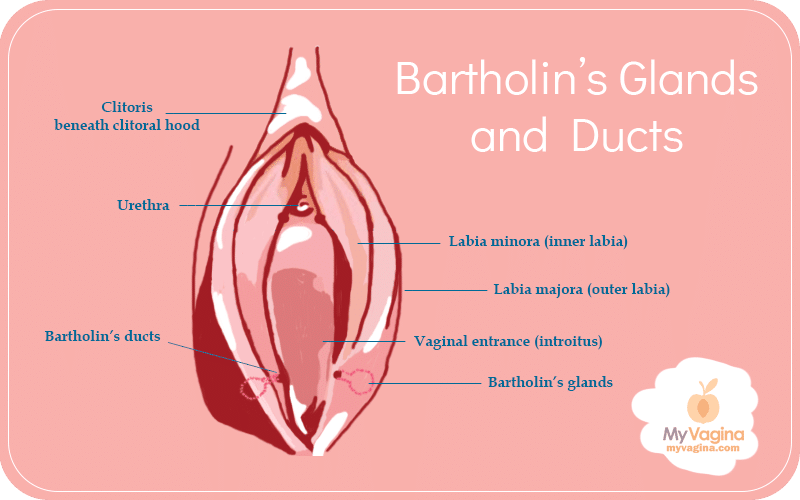Being turned on is sometimes not enough to trigger enough natural lubrication in the vagina and around the vulva to make sex comfortable and pleasurable.
While there is a complex interplay of hormonal, neurological, vascular, psychological and interpersonal elements to the vaginal wet-dry equation, here we focus on how your vagina produces lubrication during sex where you feel turned on but your vagina isn’t doing what it’s supposed to or used to.
How vaginal lubrication works
During sexual arousal, the vagina and vulva both produce fluids that make penetration comfortable, lubricating the outer and inner areas.
Outside the vagina
The vagina itself does not contain glands, but the vulva does (the Bartholin’s glands).
The Bartholin’s glands produce lubrication for the vulva via two small glands that have their exit point on either side of the vulva, at the vaginal entrance.

Inside the vagina
There are several sources of fluid inside the vagina: normal cervical fluids that produce regular discharge, and fluid excreted due to increased blood flow.
Inside the vagina, blood pressure (from increased blood flow to the area) pushes fluid from capillaries into the spaces between vaginal epithelial cells. The liquid is mostly water with some tiny proteins.
This mixture of water and proteins mixes with the top layer of (dead) epithelial cells inside the vagina to make the vaginal fluids you see and feel when you are turned on.
Blood flow to the pelvis
Having sufficient blood flow to the pelvis relies on the bioavailability of nitric oxide. Nitric oxide is produced in the surface cells of capillaries after vibration, pressure or as a response to sexual arousal (via nerves).
Nitric oxide causes blood vessels to dilate (become wider). Vaginal lubrication, thus, relies heavily on nitric oxide and its related enzymes. Oestrogen levels also impact this process.
Being turned on is sometimes not enough to trigger enough natural lubrication in the vagina and around the vulva to make sex comfortable and pleasurable.
While there is a complex interplay of hormonal, neurological, vascular, psychological and interpersonal elements to the vaginal dryness equation, here we focus on how your vagina produces lubrication during sex where you feel turned on but your vagina isn’t doing what it’s supposed to or used to.
Manipulating nitric oxide
Nitric oxide production relies on an amino acid, L-arginine. Thus, sufficient dietary intake of L-arginine supports your body’s ability to produce nitric oxide.
Before you start scarfing down peanuts, remember that a balanced diet is key, so you want to ensure optimal levels, rather than overconsumption. L-arginine has been linked with an increase in cold sore (Herpes simplex) flare-ups, so if you get cold sores, keep this in mind!
Foods high in L-arginine
- Nuts – peanuts, almonds, walnuts, hazelnuts
- Fruits – berries
- Chocolate
- Beans
- Fish, chicken
- Sunflower and flaxseed
Make sure there is sufficient dietary calcium (green leafy vegetables like broccoli, cabbage and okra, soybeans, tofu, nuts, fortified flour products, sardines or pilchards, where the bones are eaten).
You also need nitric oxide synthase, which causes the conversion of L-arginine into nitric oxide. The main factors involved in nitric oxide synthase activity include oestrogens (oestriol or oestradiol), phyto-oestrogens in soy products, testosterone, some medicines, vitamins and supplements, niacin, ginseng, and angiotensin-converting enzyme inhibitors (ACE-i).
Hyperglycaemia has a negative impact on nitric oxide synthase.
Nitric oxide activity can be prolonged by PDE-5 inhibitors such as sildenafil, tadalafil and vardenafil. These drugs are used to treat male sexual dysfunction and include brands such as Viagra.
Improving the bioavailability of nitric oxide
Some medicines, vitamins and supplements can help. Aspirin, vitamin D3, ginseng, and moderate, regular aerobic exercise all improve nitric oxide levels.
How nitric oxide works in the clitoris and vagina
Nitric oxide dilates blood vessels inside the clitoris, specifically the clitoral cavernosal tissue, which behaves similarly to the matching tissue in the penis. Clitoral cavernosal tissue is about 40-45 per cent smooth muscle and sinus cavities that are filled with blood.
When the clitoral blood supply increases, it is the result of the blood vessels dilating and smooth muscle relaxation. The clitoral structures engorge mostly because the blood flow into tissue is greater than blood flow out.
Animal and human studies show that stimulation of the pelvic nerve or clitoral cavernous nerve increases pressure inside the small spaces and increases blood flow.
Relaxation is understood to occur by electrical field stimulation, which is enhanced by the presence of nitric oxide.
What’s calcium got to do with it?
Calcium is involved in the production of nitric oxide synthase (the enzyme that kickstarts the production of nitric oxide). The way our bodies use calcium gets pretty complex, so instead of further complicating the issue, just remember: you need optimal calcium levels to enjoy greater blood flow to the vagina and clitoris.
If you are low in calcium and can’t get enough via your diet, you can take a supplement under the guidance of a practitioner. Calcium requires certain conditions to be met for it to be absorbed and utilised optimally, so before you self-prescribe, do your homework. Or, just eat calcium-rich foods regularly.
What’s oestrogen got to do with it?
Oestrogen is partially responsible for blood flow to the vagina, clitoris and vulva during the sexual response. Oestrogen has an impact on the circulatory system and regulates nitric oxide production in some cells.
Oestrogen increases blood flow and thus the fluid produced by the vagina during sexual arousal. The vagina contains a great many oestrogen receptors, while the vulva contains very few. Oestrogen is thought to keep a vagina juicy in several ways, with blood flow but one.
Ageing and menopause result in naturally lower levels of oestrogen. Surgical removal of the ovaries dramatically reduces oestrogen levels.
Oestrogens can be artificially replaced using hormone therapy, and in studies was demonstrated to normalise blood flow issues related to low oestrogen levels.
What’s testosterone got to do with it?
The role of androgens in arousal of the vagina and other structures is incompletely understood. Androgens may support nerves in the vagina, increasing the capacity for the sexual response and blood flow.
Nerves and their VIPs
Nerve fibres of the clitoris contain vasoactive intestinal polypeptide (VIP). Don’t get confused by the name – they found it in the digestive system first.
Vaginal nerves also contain other peptides that contribute to smooth muscle relaxation and blood flow.
Diabetes and vaginal lubrication
Diabetics experience more sexual dysfunction, including vaginal dryness, than non-diabetics. In animal studies, diabetic rats have reduced vaginal blood flow after pelvic nerve stimulation, with plaques on blood vessels (atherosclerosis) associated with decreases in vaginal and clitoral blood flow and incomplete vaginal and clitoral engorgement (rabbit studies).
Diabetics may have decreased capacity to produce nitric oxide and thus experience blood flow – and lubrication – problems.
References
Musicki B, Liu T, Lagoda GA, Bivalacqua TJ, Strong TD, Burnett AL. Endothelial nitric oxide synthase regulation in female genital tract structures. J Sex Med. 2009;6 Suppl 3(S3PROCEEDINGS):247–253. doi:10.1111/j.1743-6109.2008.01122.x
Myrtle Wilhite MD, MS, in Integrative Medicine (Fourth Edition), 2018
Azadzoi KM, Siroky MB. Neurologic factors in female sexual function and dysfunction. Korean J Urol. 2010;51(7):443–449. doi:10.4111/kju.2010.51.7.443
B.Ottesen, B.Pederse, J.Nielsen, D.Dalgaard, G.Wagner, J.Fahrenkrug, Vasoactive intestinal polypeptide (VIP) provokes vaginal lubrication in normal women. Peptides, Volume 8, Issue 5, September–October 1987, Pages 797-800
J. A. Barth Verlag. VIP, Vagina, Clitoral and Periurethral Glans — an Update on Human Female Genital Arousal. Exp Clin Endocrinol Diabetes 1991; 98(5): 61-69 DOI: 10.1055/s-0029-1211102.
Get a fresh perspective with a qualified, experienced vulvovaginal specialist naturopath.
This product has multiple variants. The options may be chosen on the product pageThe most comprehensive vaginal microbiome test you can take at home, brought to you by world-leading vaginal microbiome scientists at Juno Bio.
Easy-to-use BV and AV treatment program.
Promote and support a protective vaginal microbiome with tailored probiotic species.







